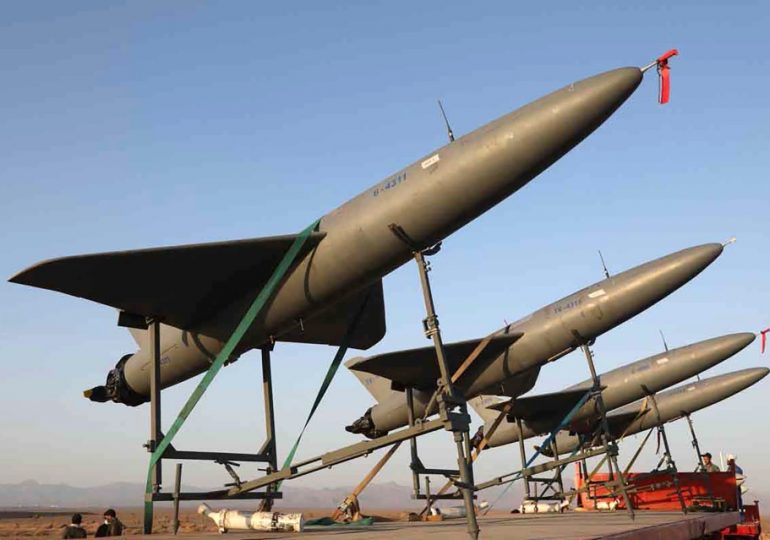IRAN today announced it has created a new suicide drone to add to its rapidly increasing arsenal of homegrown attack drones.
Despite stern international sanctions and an arms embargo, Iran has aggressively expanded its production line of unmanned aerial vehicles (UAVs) enough to waste 170 of them in its flop blitz on Israel.
APIran has focused its efforts on creating a huge arsenal of drones to inflict pain on its enemies[/caption]
Tasnim MilitaryIran’s today unveiled a new suicide drone set to rival one of Russia’s most lethal UAVs[/caption]
A drone being launched by Iran towards Israel during its 350-strong barrage on April 13
Two weeks ago, Iran fired over 350 attack drones and missiles at Israel in a failed revenge attack on Israel after its consulate in Damascus was bombed.
The five-hour attack included 170 drones, 110 ballistic missiles and 30 cruise missiles – 99 per cent of which were shot down by both Israel and its allies, including RAF Typhoons.
According to Iranian state-run media, the Iranian-made Shahed-136 and Shahed-131 kamikaze drones were used in the attack.
Supporters of the Iranian regime cheered in the streets and its leaders congratulated themselves despite the embarrassingly slow, and failed aerial show of military force.
The barrage marked the first direct attack by Tehran on its arch-foe after a long-running shadow war – but analysts claim Iran had not intended to do real harm over fears of sparking an all-out war.
But for Ukraine, it felt too close to home.
Since 2022, Iran’s relatively cheap, but deadly Shahed drones have been causing devastation on the battlefield and raining hell down on civilian targets.
And for years, Iran has been supplying its long-range drone technologies to its regional proxies including to Hamas, Hezbollah, Yemen’s Houthi rebels.
A US Defense Intelligence Agency assessment of Iran’s military strength in 2019, declared: “UAVs are Iran’s most rapidly advancing air capability.”
Since then, Tehran has been hellbent on consistently advancing its military UAV programme to make up for its lack of updated warplanes and aerial reconnaissance capabilities.
Its focus has been on developing increasingly sophisticated drones built for precision strikes.
Iran now claims to have built drones capable of stealth missions that last over 24 hours and delivering precision-guided missiles with ranges of 2,000km.
Today, Iranian state media reported its military had created a unnamed suicide drone, based of the Russian “Lancet” drone, designed for anti-ambush operations.
A report last year by United Against Nuclear Iran (UANI) described Iran’s drones as “a symbol of national pride of resilience” – a propaganda tool to inflate Iran’s military might.
“The advancement of its drone program represents a technological triumph for the Islamic Republic,” the report added.
via REUTERSTehran’s drone programme is a source of ‘national pride’[/caption]
Israel and its allies shot down 99 per cent of the projectiles
Ian Whittaker – News Group Newspapers LtdThe rubble and ruin in Kyiv following Russia launching a wave of Iranian-made kamikaze drones in 2022[/caption]
‘MESSENGER OF DEATH’
Billed as Iran’s first long-range UAV and first unveiled in 2010, the Karrar (striker) drone – dubbed Gaza – is a source of huge pride for Tehran.
The then President Mahmoud Ahmadinejad declared that the drone was meant to deter enemies and would serve as “a messenger
of death for enemies of mankind”.
Karrar, which is largely used as part of Iran’s air defences, has a range of 620 miles and pack payload of up to 500lb to destroy
targets” at “high speed”.
However, in recent years Shahed drones have largely replaced Karrars with their longer ranges and endurance.
THE SHAHEDS
Cheap, deadly, and widespread – its Shahed UAVs have proven themselves highly useful in terms of effectiveness and costs.
Its go-to model is the Shahed 136, launched in 2021.
The 136 can travel between 620 to 1,550 miles, according to various estimates, has a top speed of 115mph and weighs 200kg.
Russia refers to them as Geran-2 – and these are the lethal UAVs causing havoc for Ukraine.
Earlier models of the Shahed were used in the Syrian civil war in 2014 and represented a huge step forward in terms of Iran’s effort to create a strike combat UAV.
It increased the size, endurance and range of previous drones and is believed to have been modelled on Israel’s Hermes-450 drone.
In 2013, IRGC’s then Commander-in-Chief Maj. Gen. Mohammad-Ali Jafari said: “This aircraft is a work of art, only the US has the ability to build weapons of such a technological grade.
“All the world powers will be awestruck.”
Iran’s Shahed drones are constantly being developed with the help of smuggled Western technology.
They are usually launched as a swarm to overwhelm enemy air defences and increase the chance of a successful missile attack.
IRANIAN DRONES IN UKRAINE
In late August 2022, Iran is believed to have started shipping drones to Russia, however other estimates suggest that deliveries had arrived ahead of the full-scale invasion.
Both Tehran and Moscow deny the drone imports, despite constant evidence of Iranian-made drones being used on the battlefield and also smashing into civilian homes.
UANI’s 2023 report argued that the war has been “useful” for Iran to test its drone’s utility and prepare improvements.
It also said the regime was using the war to “advertise its drones worldwide” for governments in Venezuela, Bolivia, Ethiopia, Sudan, and China to take note of their skills.
As of February, Russia is believed to have launched over 4,600 Shahed drones.
On April 14, the morning after Iran’s attack on Israel, President Voloydmyr Zelensky announced that Russia had launched 130 Shahed drones at Ukraine in the last week.
On New Year, Russia launched a record 90 drones at Ukraine, of which 87 were shot down.
ReutersIranian drone or missile debris falling from the sky during the attacks two weeks ago[/caption]
Iranians drive past an anti-Israel billboard carrying pictures of Iranian missiles in Tehran
APIsraelis posing next to the down missiles[/caption]
Iranians burn Israeli and US flags during a recent protest
A down Iranian ballistic missile lies on the shore of the Dead Sea
Leave a comment








